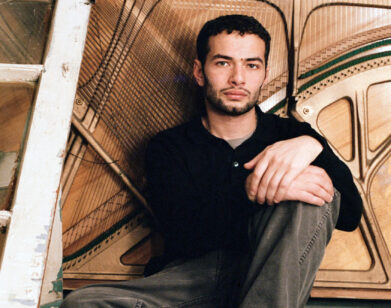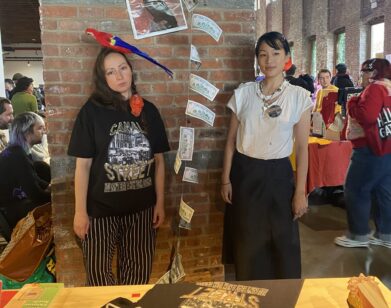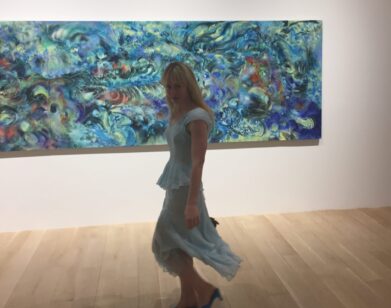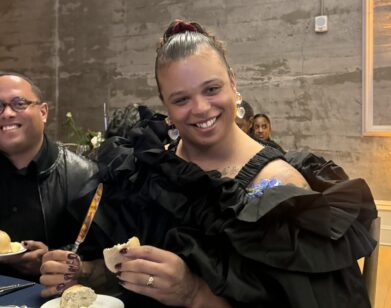Javier Peres: The Third K is for Kindness
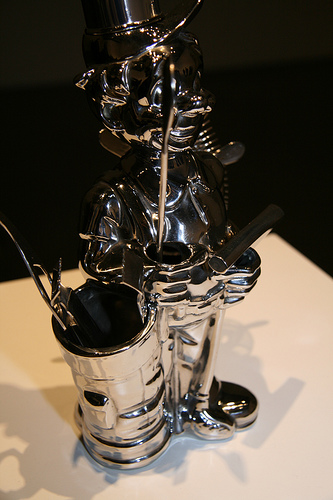
Javier Peres at the after-party for KKK. Mary Boone, Terence Koh and friends in front of Koh’s wall-length urinal. All photos by Porter Hovey.
Javier Peres is the bon vivant dealer behind Peres Projects, who for the last decade has outsmarted by secreting his arresting intelligence and authenticity. With the economy in flux, he faces unique challenges of defending his penchant for access. He’s also in a unique position to overcome the market. Peres’ latest coup is the three-person show, “KKK,” which he curated at Mary Boone’s monumental Chelsea space—a show that combines one artist he famously represents and two that he does not. Jeff Koons and Mike Kelley came a generation (or two) before Terence Koh, and both are clearly an influence on him. Unsurprisingly, “KKK” is a show that takes on the place of scandal and abjection in contemporary art, one that comes to some surprisingly quiet conclusions. Koons’ stainless steel “Baccarat Crystal Set” (1989) is a tasteful take on the artist’s signature high-gloss kitsch. In the past Koh has adapted Koons’ signature approach, painting huge installations of his idiosyncratic personal property entirely white, black or gold and displaying them in cracked vitrines. Likewise, using cum or chocolate (both of which diseintegrate, or else acquire filth), Koh’s work revels in the Kelley’s exploration of abjection—what the former has mixed up and turned around, and called “love and all manner of faggy filth.” And then of course there’s fame, which Koh has so eagerly courted that no one knows whether it’s abject or not.
ANA FINEL HONIGMAN: You meant to choose three artists with the initial K, right?
JAVIER PERES: Well, not exactly. I don’t actually even recall what the original idea for the show was. It has been through several changes as we worked to secure existing works from Koons and Kelley, and even as I confirmed what work Terence would make for the show. The main reason for me to do the show was to do a really simple, almost stupid, sculpture show, with no real pretense other than showing strong objects by three of my favorite living artists, who use sculpture as major part of their creative output.
AFH: I just spent forever trying to figure out the relationship between the KKK and
contemporary sculpture. Are you interested in political readings of these artists’ work?
JP: They are hard to miss sometimes, although at others there is no political reading to be had in any of their works. I also find this interesting. Political art, per se, is really not interesting to me. Not at all.
Koons, Kelley
AFH: Do you think of Terence as the ideal child to the works of Kelley and Koons?
JP: Well, truthfully I think Terence’s parents would be upset with me if I said he was. Plus I am sure neither Kelley or Koons is in the market for a kid, especially not a grown up one like Terence. But all three artists do present very playful ideas in their works.
AFH: Do you see Koons and Kelley as conceptually akin to each other, or have you brought them together because of their differences?
JP: I have brought them together solely for their differences. I see this show as not making any sense, not being about anything in particular, as having no point of view, nor needing one for that matter, it is a show about nothing other than looking at objects in a gallery, then walking out and going on with your day.
AFH: Koh’s aesthetic and interests seem like the perfect synthesis of the two. Are you interested in putting Koh’s work in that context with this show?
JP: Yes, totally. Of course, we all know that I have championed Terence’s work from the beginning and as such I have a level of knowledge and understanding of his work that I feel gives me so many insights on the man and his art.
AFH: Do Koh, Kelley and Koons know each other?
JP: They have all met at different points.
AFH: Do they see corollaries among their work?
JP: Not particularly.
AFH: When you curate group shows, are you concerned with whether the artists agree with your premise?
JP: Not really. I never spoke to either Jeff Koons or Mike Kelley about this show but they both knew of it and Mary made arrangements. Should I have done that?
AFH: What brings you and Mary Boone together?
JP: We met through Jose Freire of Team Gallery who did a series of shows with her and included some of the artists that I represent. Before I knew it, I was deep in the world of Mary, and totally in awe of her. I have tons of respect and admiration for her, she is such a force and at the same time such an incredibly generous and sweet person. It was Mary
that made it possible for both the Whitney and the Tate to acquire sculptures by Terence for their permanent collection, so needless to say working with her is a great experience and I am learning a great deal.
AFH: Do you plan to show some of her artists in Berlin or LA, like an exchange program?
JP: We haven’t spoken of any other future plans, but it would be great. I do have another idea for a show in her place. I call it “golden showers: a manifesto.” Hopefully we can realize it one day!
AFH: Now that the economy has turned that show sounds nice and nostalgic. A lot of the artists affiliated with the gallery were bestowed, or burdened, with “art star” status. Are you worried that there is a backlash against what their success represented during boom times? Do you think these artists, Terence included, are getting a raw deal now that some people are feeling justified in their bitterness or possibly jealousy?
JP: I hope not. People don’t always deal with success well, on both sides of the coin. Some artists blow up and act out. This is not a good idea. It really is important to remember where you are coming from and that luck is the mother of all successes and all failure. Your stock in life can change very quickly.
AFH: How will the new era of restraint and moderation affect the ethos and vibe of your gallery?
JP: Hopefully not too much; restraint isn’t really something I am that interested in, but of course we are looking to and finding new ways to accommodate what we want to do and what can be done given the global economic reality—mainly less travel, and longer exhibitions in our different locations.
AFH: What do you think is the ideal dealer-artist relationship? Are you like the artists’ daddy or are you more like another dog in the pack?
JP: I am both a dog in the pack, or a dog in heat, and also a daddy. I play many roles in my relationship with the artists I represent, but ideally for me, what I think is the best way to work is when you are both striving for the same goals. Do the best you can for each other, but at the end of the day also recognize that we are both humans and that we can make mistakes, not intending to, but they can just happen, and we both work to move on and get back on track.
See Art in America online for coverage of the opening of KKK.


